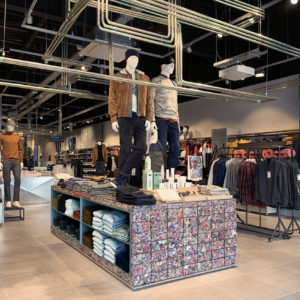

Have you ever struggled over what to do with worn out, frayed, stained or ripped clothing? You can’t really hand it down, pass it on, put it in a garage sale or donate it, like you might if it were still in decent shape and you were simply tired of it. Most of us would probably just toss it. But one young architecture student has found a better way.
Meet Clarisse Merlet, creator of FabBRICK. Clarisse was in her fifth year at Paris’s ENSA Paris-Malaquais researching new approaches to construction when she had an idea for giving worn-out clothing new life by turning it into something beautiful and functional.
Basically, Clarisse takes worn, torn, unusable clothing that would otherwise pile up in landfills and turns it into “bricks” that can be used for building partition walls and furniture or simply for decoration.
 Upcycling this type of waste is a refreshing idea, not only in Europe where four million tons of textiles are tossed every year, but even in the U.S., which discards a whopping 14 million tons of textiles annually.
Upcycling this type of waste is a refreshing idea, not only in Europe where four million tons of textiles are tossed every year, but even in the U.S., which discards a whopping 14 million tons of textiles annually.
Here’s how it works: First, the shredded fabric is combined with an eco-friendly glue Clarisse developed herself. Then the mixture is transferred to another of her creations, a unique brick-molding device powered solely by human energy, no electricity required. The wet bricks are removed and allowed to air dry up to two weeks. All materials are bio-sourced and non-polluting, and Clarisse and her team can pump out over 1,000 “FabBRICKs” a week.
 While the bricks respond well to fire and humidity, they are not currently sturdy enough for home construction. However, Clarisse’s 2020 to do list includes creating bricks (and the machinery to mold them) suitable for building homes, with a goal of eventually helping to reduce the use of natural resources like wood, sand and oil within the construction industry.
While the bricks respond well to fire and humidity, they are not currently sturdy enough for home construction. However, Clarisse’s 2020 to do list includes creating bricks (and the machinery to mold them) suitable for building homes, with a goal of eventually helping to reduce the use of natural resources like wood, sand and oil within the construction industry.
 What do you think, Movement members? Would you consider using a material like FabBRICK in your home or apartment? We’d love to read your thoughts in the comments below.
What do you think, Movement members? Would you consider using a material like FabBRICK in your home or apartment? We’d love to read your thoughts in the comments below.Resources:
I love this!
The making of the bricks video was Awesome.
How creative! A beautiful way to recycle. Hope Clarisse continues her efforts.
What an INCREDIBLE invention!! LOVE IT!!!
These bricks would definitely make a statement piece of furniture. I would use them for shelving units, a table, benches….there are so many creative ways to use these bricks!
This is a great idea. Is there a way to donate our ripped clothing?
Thanks for your question, Cindy! I couldn’t locate the answer on the FabBrick website; however I did find a link to a form you can use to email your question, if you’d like to pursue it. Please visit https://www.fab-brick.com/contact.
My local St Vincent de Paul thrift store takes laundered “rags”. They sell it, to a company that reuses clothing. Not used for bricks, but keeps cloth out of the landfill.
Love this idea! I would love to be able to donate unsalable clothing to a great project like this to keep them from going to landfills.
So innovative and gives us yet another option for sustainable living.
I love this idea!!!
Neat idea! I hope she continues to grow and expand these efforts. I wouldn’t mind a few for myself too!
Where do you donate used clothing for this?
Thanks for your question, Cheri! We couldn’t locate the answer on the FabBrick website; however we did find a link to a form you can use to email your question, if you’d like to pursue it. Please visit https://www.fab-brick.com/contact.
Why to go Clarisse Merlet! That’s using your head!
Such a creative and intelligent difference in making the world a better place.
Very proud of you!
Love the video. The brick making was interesting.
My meal kit recycling used to come fabric insulation. I had some left over and just used it to insulate around the basement window in my office. The new ones are another type material. We still reuse all of them too. We have dispersed them into our attic (obviously not our first defense, but just a little extra). Our current project is insulating between our basement ceiling and main level as we remodel our basement.
w
Do you know if there is a place in SW Ontario (or elsewhere) where textiles can be donated for the purpose of recycling. The recycling programs in Ontario do not even accept textiles. I am sure people would be thrilled to support this project and could provide years of free recycled “raw materials” if there were some drop-off point(s) in major cities.
great job, I am interested in the making can you please tell me the composition of glue you use please
Great idea! Love this.